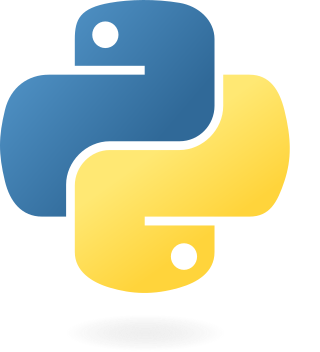Related Research Articles

Python is a high-level, general-purpose programming language. Its design philosophy emphasizes code readability with the use of significant indentation.

Perl is a high-level, general-purpose, interpreted, dynamic programming language. Though Perl is not officially an acronym, there are various backronyms in use, including "Practical Extraction and Reporting Language".

PHP is a general-purpose scripting language geared towards web development. It was originally created by Danish-Canadian programmer Rasmus Lerdorf in 1993 and released in 1995. The PHP reference implementation is now produced by the PHP Group. PHP was originally an abbreviation of Personal Home Page, but it now stands for the recursive initialism PHP: Hypertext Preprocessor.

Ruby is an interpreted, high-level, general-purpose programming language. It was designed with an emphasis on programming productivity and simplicity. In Ruby, everything is an object, including primitive data types. It was developed in the mid-1990s by Yukihiro "Matz" Matsumoto in Japan.
Yukihiro Matsumoto, also known as Matz, is a Japanese computer scientist and software programmer best known as the chief designer of the Ruby programming language and its original reference implementation, Matz's Ruby Interpreter (MRI). His demeanor has brought about a motto in the Ruby community: "Matz is nice and so we are nice," commonly abbreviated as MINASWAN.

Apache Groovy is a Java-syntax-compatible object-oriented programming language for the Java platform. It is both a static and dynamic language with features similar to those of Python, Ruby, and Smalltalk. It can be used as both a programming language and a scripting language for the Java Platform, is compiled to Java virtual machine (JVM) bytecode, and interoperates seamlessly with other Java code and libraries. Groovy uses a curly-bracket syntax similar to Java's. Groovy supports closures, multiline strings, and expressions embedded in strings. Much of Groovy's power lies in its AST transformations, triggered through annotations.
JRuby is an implementation of the Ruby programming language atop the Java Virtual Machine, written largely in Java. It is free software released under a three-way EPL/GPL/LGPL license. JRuby is tightly integrated with Java to allow the embedding of the interpreter into any Java application with full two-way access between the Java and the Ruby code.

Jonathan Gillette, known by the pseudonym why the lucky stiff, is a writer, cartoonist, artist, and programmer notable for his work with the Ruby programming language. Annie Lowrey described him as "one of the most unusual, and beloved, computer programmers" in the world. Along with Yukihiro Matsumoto and David Heinemeier Hansson, he was seen as one of the key figures in the Ruby community. His pseudonym might allude to the exclamation "Why, the lucky stiff!" from The Fountainhead by Ayn Rand.

Scala is a strong statically typed high-level general-purpose programming language that supports both object-oriented programming and functional programming. Designed to be concise, many of Scala's design decisions are intended to address criticisms of Java.
YARV is a bytecode interpreter that was developed for the Ruby programming language by Koichi Sasada. The goal of the project was to greatly reduce the execution time of Ruby programs.

The Sony NEWS is a series of Unix workstations sold during the late 1980s and 1990s. The first NEWS machine was the NWS-800, which originally appeared in Japan in January 1987 and was conceived as a desktop replacement for the VAX series of minicomputers.

Ikarus Scheme is a free software optimizing incremental compiler for R6RS Scheme that compiles directly to the x86 IA-32 architecture. Ikarus is the first public implementation of a large part of the R6RS Scheme standard. Version 0.0.3 has 94% of the total R6RS forms and procedures. Development stopped in 2008.

Matz's Ruby Interpreter or Ruby MRI is an implementation of the Ruby programming language named after Ruby creator Yukihiro Matsumoto ("Matz"). Until the specification of the Ruby language in 2012, the MRI implementation was considered the de facto reference, especially since an independent attempt to create the specification (RubySpec) had failed. Starting with Ruby 1.9, and continuing with Ruby 2.x and above, the official Ruby interpreter has been YARV.
Heroku is a cloud platform as a service (PaaS) supporting several programming languages. As one of the first cloud platforms, Heroku has been in development since June 2007, when it supported only the Ruby programming language, but now also supports Java, Node.js, Scala, Clojure, Python, PHP, and Go. For this reason, Heroku is said to be a polyglot platform as it has features for a developer to build, run and scale applications in a similar manner across most of these languages. Heroku was acquired by Salesforce in 2010 for $212 million.
MacRuby is a discontinued implementation of the Ruby language that ran on the Objective-C runtime and CoreFoundation framework under development by Apple Inc. which "was supposed to replace RubyCocoa". It targeted Ruby 1.9 and used the high performance LLVM compiler infrastructure starting with version 0.5. It supports both ahead-of-time and just-in-time compilation.

Rust is a multi-paradigm, general-purpose programming language that emphasizes performance, type safety, and concurrency. It enforces memory safety—meaning that all references point to valid memory—without a garbage collector. To simultaneously enforce memory safety and prevent data races, its "borrow checker" tracks the object lifetime of all references in a program during compilation.
Elixir is a functional, concurrent, high-level general-purpose programming language that runs on the BEAM virtual machine, which is also used to implement the Erlang programming language. Elixir builds on top of Erlang and shares the same abstractions for building distributed, fault-tolerant applications. Elixir also provides tooling and an extensible design. The latter is supported by compile-time metaprogramming with macros and polymorphism via protocols.

mruby is an interpreter for the Ruby programming language with the intention of being lightweight and easily embeddable. The project is headed by Yukihiro Matsumoto, with over 100 contributors currently working on the project.

Nim is a general-purpose, multi-paradigm, statically typed, compiled high-level systems programming language, designed and developed by a team around Andreas Rumpf. Nim is designed to be "efficient, expressive, and elegant", supporting metaprogramming, functional, message passing, procedural, and object-oriented programming styles by providing several features such as compile time code generation, algebraic data types, a foreign function interface (FFI) with C, C++, Objective-C, and JavaScript, and supporting compiling to those same languages as intermediate representations.

Crystal is a high-level general-purpose, object-oriented programming language, designed and developed by Ary Borenszweig, Juan Wajnerman, Brian Cardiff and more than 400 contributors. With syntax inspired by the language Ruby, it is a compiled language with static type-checking, but specifying the types of variables or method arguments is generally unneeded. Types are resolved by an advanced global type inference algorithm. Crystal is currently in active development. It is released as free and open-source software under the Apache License version 2.0.
References
- ↑ Ruby Releases
- ↑ Ruby Maintenance Branches
- ↑ "The Ruby Community's Christmas Releases". www.rubyinside.com.
- ↑ "A Patch in Time: Securing Ruby".
- ↑ "ruby-1.8.0 released!". www.ruby-lang.org.
- ↑ "Plans for 1.8.7". www.ruby-lang.org.
- ↑ "EOL for Ruby 1.8.7 and 1.9.2". www.ruby-lang.org.
- ↑ "Ruby 1.9.3-p551 Released". www.ruby-lang.org.
- ↑ "Ruby 1.9.0 Released". www.ruby-lang.org.
- ↑ "Support for Ruby version 1.9.3 will end on February 23, 2015". www.ruby-lang.org.
- ↑ "Support for Ruby 1.9.3 has ended". www.ruby-lang.org.
- 1 2 3 "Ruby 2.0.0-p648 Released". www.ruby-lang.org.
- ↑ "Ruby 2.0.0-p0 is released". www.ruby-lang.org.
- 1 2 "Ruby 2.1.10 Released". www.ruby-lang.org.
- ↑ "Ruby 2.1.0 is released". www.ruby-lang.org.
- ↑ "Support plans for Ruby 2.0.0 and Ruby 2.1". www.ruby-lang.org.
- ↑ "Ruby Issue Tracking System". bugs.ruby-lang.org.
- ↑ "Support of Ruby 2.1 has ended". www.ruby-lang.org.
- ↑ "Ruby 2.2.10 Released". www.ruby-lang.org.
- ↑ "Ruby 2.2.0 Released". www.ruby-lang.org.
- ↑ "Ruby 2.2.7 Released". www.ruby-lang.org.
- ↑ "Support of Ruby 2.2 has ended". www.ruby-lang.org.
- ↑ "Ruby 2.3.8 Released". www.ruby-lang.org.
- ↑ "Ruby 2.3.0 Released". www.ruby-lang.org.
- 1 2 "Support of Ruby 2.3 has ended". www.ruby-lang.org. 2019-03-31.
- ↑ "Ruby 2.4.10 Released". Ruby Programming Language. 2020-03-31. Retrieved 2020-04-01.
- ↑ "Ruby 2.4.0 Released". www.ruby-lang.org.
- 1 2 "Support of Ruby 2.4 has ended". www.ruby-lang.org.
- 1 2 3 "Ruby 2.5.9 Released". Ruby Programming Language. 2021-04-05. Retrieved 2021-04-05.
- ↑ "Ruby 2.5.0 Released". www.ruby-lang.org.
- 1 2 3 "Ruby 2.6.10 Released". www.ruby-lang.org. 2022-04-12. Retrieved 2023-07-04.
- ↑ "Ruby 2.6.0 Released". www.ruby-lang.org.
- 1 2 3 "Ruby 2.7.8 Released". www.ruby-lang.org. 2023-03-30. Retrieved 2023-05-23.
- ↑ "Ruby 2.7.0 Released". www.ruby-lang.org. 2019-12-25.
- 1 2 "Ruby 3.0.7 Released". www.ruby-lang.org. 2024-04-23. Retrieved 2024-04-29.
- ↑ "Ruby 3.0.0 Released". www.ruby-lang.org. 2020-12-25.
- ↑ "Ruby 3.1.5 Released". www.ruby-lang.org. 2024-04-23. Retrieved 2024-04-29.
- ↑ "Ruby 3.1.0 Released". www.ruby-lang.org. 2021-12-25.
- ↑ "Ruby 3.2.5 Released". www.ruby-lang.org. 2024-04-23. Retrieved 2024-04-29.
- ↑ "Ruby 3.2.0 Released". www.ruby-lang.org. 2022-12-25. Retrieved 2024-04-29.
- ↑ "Ruby 3.3.1 Released". www.ruby-lang.org. 2024-04-23. Retrieved 2024-04-29.
- ↑ "Ruby 3.3.0 Released". www.ruby-lang.org. 2023-12-25. Retrieved 2024-04-29.
- ↑ Shugo Maeda (17 December 2002). "The Ruby Language FAQ" . Retrieved 2 March 2014.
- ↑ Matsumoto, Yukihiro (13 February 2006). "Re: Ruby's lisp features" . Retrieved 15 February 2020.
- 1 2 3 4 5 6 "History of Ruby".
- ↑ "[FYI: historic] The decisive moment of the language name Ruby. (Re: [ANN] ruby 1.8.1)" (E-mail from Hiroshi Sugihara to ruby-talk).
- ↑ "1.3 Why the name 'Ruby'?". The RFFuby Language FAQ. Ruby-Doc.org. Retrieved April 10, 2012.
- ↑ Yukihiro Matsumoto (June 11, 1999). "Re: the name of Ruby?". Ruby-Talk (Mailing list). Retrieved April 10, 2012.
- ↑ "More archeolinguistics: unearthing proto-Ruby". Archived from the original on 6 November 2015. Retrieved 2 May 2015.
- ↑ "[ruby-talk:00382] Re: history of ruby" . Retrieved 2 May 2015.
- ↑ "[ruby-list:124] TUTORIAL — ruby's features" . Retrieved 2 May 2015.
- ↑ "An Interview with the Creator of Ruby".
- ↑ Yukihiro Matsumoto (October 2000). "Programming Ruby: Forward" . Retrieved 5 March 2014.
- ↑ "We retire Ruby 1.8.7" . Retrieved 2 May 2015.
- ↑ "IPA 独立行政法人 情報処理推進機構:プレス発表 プログラム言語RubyのJIS規格(JIS X 3017)制定について" . Retrieved 2 May 2015.
- ↑ "IPA 独立行政法人 情報処理推進機構:プレス発表 プログラム言語Ruby、国際規格として承認" . Retrieved 2 May 2015.
- ↑ "ISO/IEC 30170:2012" . Retrieved 2017-03-10.
- ↑ Web Development: Ruby on Rails. Devarticles.com (2007-03-22). Retrieved on 2013-07-17.
- ↑ "Ruby 1.9.3 p0 is released". ruby-lang.org. October 31, 2011. Retrieved February 20, 2013.
- ↑ "v1_9_3_0/NEWS". Ruby Subversion source repository. ruby-lang.org. September 17, 2011. Retrieved February 20, 2013.
- ↑ Ruby 1.9: What to Expect. slideshow.rubyforge.org. Retrieved on 2013-07-17.
- ↑ "Support for Ruby 1.9.3 has ended" . Retrieved 2 May 2015.
- ↑ Endoh, Yusuke. (2013-02-24) Ruby 2.0.0-p0 is released. Ruby-lang.org. Retrieved on 2013-07-17.
- ↑ Endoh, Yusuke. (2013-02-24) Ruby 2.0.0-p0 is released. Ruby-lang.org. Retrieved on 2013-07-17.
- ↑ usa (2016-02-24). "Support plans for Ruby 2.0.0 and Ruby 2.1". Ruby-lang.org. Retrieved 2017-04-18.
- ↑ "Ruby 2.1.0 is released". December 25, 2013. Retrieved December 26, 2013.
- ↑ "Semantic Versioning starting with Ruby 2.1.0". December 21, 2013. Retrieved December 27, 2013.
- ↑ "Support for Ruby 2.1 has ended" . Retrieved 4 April 2017.
- ↑ "Ruby 2.2.0 Released". December 25, 2014. Retrieved January 4, 2015.
- ↑ "ruby/NEWS at v2_2_0 · ruby/ruby · GitHub". GitHub. Retrieved 2 May 2015.
- ↑ "Support of Ruby 2.2 has ended" . Retrieved 29 Dec 2019.
- ↑ Gustavo Frederico Temple Pedrosa, Vitor de Lima, Leonardo Bianconi (2015). "Ruby 2.2.1 Released" . Retrieved 12 July 2016.
{{cite web}}: CS1 maint: multiple names: authors list (link) - ↑ Gustavo Frederico Temple Pedrosa, Vitor de Lima, Leonardo Bianconi (2015). "v2.2.1 ChangeLog" . Retrieved 12 July 2016.
{{cite web}}: CS1 maint: multiple names: authors list (link) - ↑ Gustavo Frederico Temple Pedrosa, Vitor de Lima, Leonardo Bianconi (2014). "Specifying non volatile registers for increase performance in ppc64" . Retrieved 12 July 2016.
{{cite web}}: CS1 maint: multiple names: authors list (link) - ↑ Gustavo Frederico Temple Pedrosa, Vitor de Lima, Leonardo Bianconi (2014). "Specifying MACRO for increase performance in ppc64" . Retrieved 12 July 2016.
{{cite web}}: CS1 maint: multiple names: authors list (link) - ↑ "Ruby 2.3.0 changes and features". Running with Ruby. dev.mensfeld.pl. 14 November 2015.
- ↑ "Ruby/NEWS at v.2_3_0 - ruby/ruby". GitHub. Retrieved 25 December 2015.
- ↑ "Ruby 2.4.0 Released". www.ruby-lang.org. Retrieved 2016-12-30.
- ↑ "Ruby 2.5.0 Released" . Retrieved 2018-05-02.
- ↑ "Ruby 2.6.0 Released". Ruby Programming Language. 2018-12-25. Retrieved 2018-12-25.
- ↑ "Ruby 2.7.0 Released". Ruby Programming Language. 2019-12-25. Retrieved 2019-12-25.
- ↑ "Ruby 3.0.0 Released". Ruby Programming Language. 2020-12-25. Retrieved 2020-12-25.
- ↑ "Ruby 3.1.0 Released". Ruby Programming Language. 2021-12-25. Retrieved 2022-12-26.
- ↑ "Ruby 3.2.0 Released". Ruby Programming Language. 2022-12-25. Retrieved 2022-12-26.
- ↑ "Ruby 3.3.0 Released". Ruby Programming Language. 2023-12-25. Retrieved 2024-04-29.